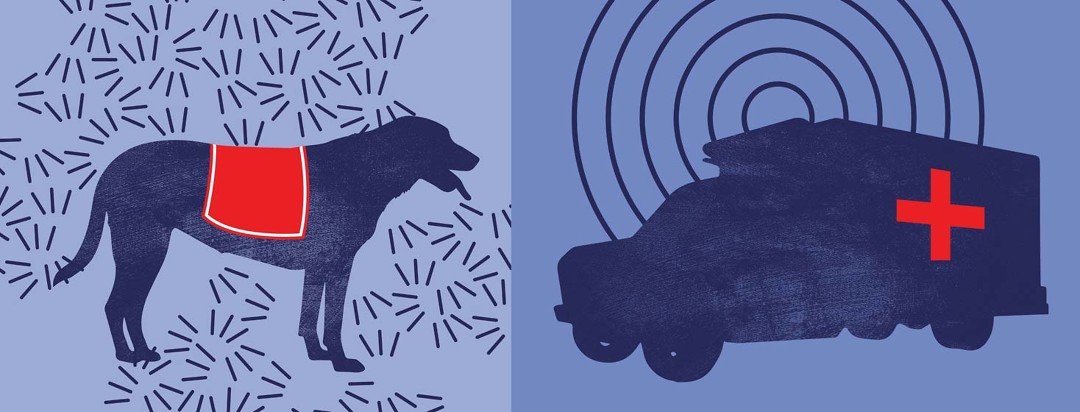Service Dogs vs. Allergies and Asthma: Finding a Middle-Ground for Access
There is a frequent debate in the asthma community around the impact of service dogs on asthma and allergy symptoms. There is often no “good” solution here around ensuring people with disabilities who use service dogs have the required right-to-access spaces, while also keeping people with allergies and asthma safe.
A good, though imperfect, solution
Recently, a friend who is a service dog user posted a photo of a sign at a local store that read: “SERVICE DOGS: You are welcome! HOWEVER—Please inform management PRIOR to entering the store due to severe allergic reactions of an employee (and possibly customers). You can call the store at [number redacted]. Thank you for your understanding!” Emphasis is as it was pictured on the sign.
In this situation, the friend who posted this on their service dog page notes, “The local community here is aware of the time an employee here had to be taken by ambulance due to a severe reaction. As a service dog handler, I respect their need for accommodation.” (They have, to this point, requested to remain anonymous.)
The sign makes a strong point: with thoughtfulness, it is possible to accommodate both people with service dogs and their employees (and other customers) with severe allergies.
Community conversations around service dogs and asthma
I think it’s important to recap some of the conversations that followed here. For instance, as I myself have many friends who are blind and use guide dogs, I, of course, initially thought of the futility of the sign for guide dog users, sharing the post saying:
“A+ work for this store accommodating both service dog users and those with severe allergies. Now, how to ensure this is usable by guide dog users is another hurdle, but this is a really, really good start for reasonable accommodation practices.”
Accounting for blindness
A friend quickly commented similarly, saying:
“I have a question though: if [someone] is blind… does the dog read this and check in?”
The sign is, of course, for some, the equivalent of being told to ask for the ramp at the front desk. This, of course, is physically inaccessible due to stairs...
This friend was being silly, but I replied that, as above, the situation was known in the community, and “I would presume this has been circulated among the local blind/VI (visually impaired) community and is known.” If this were a situation here in Winnipeg, I do not doubt that the blind/VI community would have discussed this among themselves for those using guide dogs.
Communication and Physical Barriers
Yet another consideration is that the sign also assumes the person can make a phone call (and has a cell phone) or can text the phone number, and assumes they can physically stand and wait with their service dog while arrangements are made.
Of course, I noted we don’t know the rest of the surroundings—maybe there is a bench or chair right outside, too.
I also reminded them I said it was a good start—not that it was perfect!
Another friend, who has severe allergies and asthma, and has in the past advocated for more sensible rules around pets on planes (note: pets, not trained/certified service animals), simply replied “most awesome…”. Simple solutions, such as a sign, are still effective and can lead to a more inclusive society, one that considers these issues from multiple perspectives on disability.
Making accommodations for everyone
Right-to-access can be tricky. However, from everything I have seen, with proper warning and forethought, people with disabilities are typically happy to be accommodating of other people’s disabilities, as long as their rights as a person with a disability are also appreciated and not put in jeopardy. After all, they unquestionably understand what it is like to be denied access to a space for whatever reason, and they certainly don’t want to be the cause of that for others. Yes, it can take compromise, and yes, there is room for error or imperfection. But simply existing with a disability in public, even in so-called accessible spaces, comes with hurdles, too.
After all, even though fragrances cause mild-to-severe reactions for many of us, like allergies and asthma do, they certainly have not been banned in public spaces or on airplanes. This is despite the fact that they aren’t critical to anyone’s needs and are problematic for many of us! Unlike this simplified example, the discussion around service dogs and people with asthma and allergies is unquestionably more nuanced, with both groups being protected under various pieces of legislation.
Awareness of service dogs and allergies and asthma
I see daily through friends the importance of their guide dogs, assistance dogs, and diabetes alert dogs in ensuring they have equal access to the world as people with disabilities. I also know first-hand the issues faced by those with asthma and allergies.
I know this is not an easy issue to create policy around. However, I believe that simply having these conversations can help people become aware of more creative solutions to ensuring that everyone’s access to all spaces is respected. Even if it takes us more innovation and creativity to get there, I certainly don’t have the answers!
What are your thoughts on accommodating those with service dogs as well as people with allergies and asthma? Share in the comments below!

Join the conversation